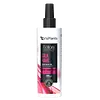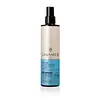What's inside
What's inside
 Key Ingredients
Key Ingredients

No key ingredients
 Benefits
Benefits

 Concerns
Concerns

 Ingredients Side-by-side
Ingredients Side-by-side

Water
Skin ConditioningCyclopentasiloxane
EmollientPhenyl Trimethicone
Skin ConditioningDimethiconol
EmollientPolyquaternium-16
Panthenol
Skin ConditioningHydrolyzed Silk
HumectantHydrolyzed Wheat Protein
Skin ConditioningHydroxypropyltrimonium Hydrolyzed Wheat Protein
Skin ConditioningLactic Acid
BufferingCetrimonium Chloride
AntimicrobialPEG-12 Dimethicone
Skin ConditioningCyclohexasiloxane
EmollientParfum
MaskingPhenoxyethanol
PreservativeImidazolidinyl Urea
PreservativePotassium Sorbate
PreservativeBenzophenone-4
UV AbsorberHexyl Cinnamal
PerfumingLinalool
PerfumingLimonene
PerfumingAlpha-Isomethyl Ionone
PerfumingCoumarin
PerfumingBenzyl Salicylate
PerfumingCI 16185
Cosmetic ColorantSodium Sulfate
Water, Cyclopentasiloxane, Phenyl Trimethicone, Dimethiconol, Polyquaternium-16, Panthenol, Hydrolyzed Silk, Hydrolyzed Wheat Protein, Hydroxypropyltrimonium Hydrolyzed Wheat Protein, Lactic Acid, Cetrimonium Chloride, PEG-12 Dimethicone, Cyclohexasiloxane, Parfum, Phenoxyethanol, Imidazolidinyl Urea, Potassium Sorbate, Benzophenone-4, Hexyl Cinnamal, Linalool, Limonene, Alpha-Isomethyl Ionone, Coumarin, Benzyl Salicylate, CI 16185, Sodium Sulfate
Water
Skin ConditioningCyclopentasiloxane
EmollientAlcohol Denat.
AntimicrobialIsohexadecane
EmollientPanthenol
Skin ConditioningSimmondsia Chinensis Seed Oil
EmollientPersea Gratissima Oil
Skin ConditioningButyrospermum Parkii Butter
Skin ConditioningLactobacillus Ferment
Skin ConditioningChitosan PCA
HumectantHydrolyzed Keratin
HumectantHydrolyzed Silk
HumectantPEG-40
HumectantHydrogenated Castor Oil
EmollientPPG-26-Buteth-26
Skin ConditioningPolyquaternium-44
Polyglyceryl-3 Ricinoleate
EmulsifyingTrideceth-9
EmulsifyingPolyglyceryl-4 Caprate
EmulsifyingPEG-15 Cocopolyamine
EmulsifyingPropylene Glycol
HumectantCitric Acid
BufferingDimethiconol
EmollientAlpha-Isomethyl Ionone
PerfumingCoumarin
PerfumingGeraniol
PerfumingLimonene
PerfumingPolyquaternium-10
Linalool
PerfumingCinnamyl Alcohol
PerfumingCitronellol
PerfumingCI 42090
Cosmetic ColorantCitral
PerfumingCI 60725
Cosmetic ColorantHydrolyzed Wheat Protein
Skin ConditioningCinnamyl Cinnamate
PerfumingBenzyl Alcohol
PerfumingPhenoxyethanol
PreservativeSodium Benzoate
MaskingHydroxyethylcellulose
Emulsion StabilisingParfum
MaskingWater, Cyclopentasiloxane, Alcohol Denat., Isohexadecane, Panthenol, Simmondsia Chinensis Seed Oil, Persea Gratissima Oil, Butyrospermum Parkii Butter, Lactobacillus Ferment, Chitosan PCA, Hydrolyzed Keratin, Hydrolyzed Silk, PEG-40, Hydrogenated Castor Oil, PPG-26-Buteth-26, Polyquaternium-44, Polyglyceryl-3 Ricinoleate, Trideceth-9, Polyglyceryl-4 Caprate, PEG-15 Cocopolyamine, Propylene Glycol, Citric Acid, Dimethiconol, Alpha-Isomethyl Ionone, Coumarin, Geraniol, Limonene, Polyquaternium-10, Linalool, Cinnamyl Alcohol, Citronellol, CI 42090, Citral, CI 60725, Hydrolyzed Wheat Protein, Cinnamyl Cinnamate, Benzyl Alcohol, Phenoxyethanol, Sodium Benzoate, Hydroxyethylcellulose, Parfum
Ingredients Explained
These ingredients are found in both products.
Ingredients higher up in an ingredient list are typically present in a larger amount.
Alpha-Isomethyl Ionone is a fragrance. It can be synthetically created or naturally occurring.
The scent of Alpha-Isomethyl Ionone is described as "flowery" but can also be "woody".
Naturally occurring Alpha-Isomethyl Ionone may be found in Saccharomyces cerevisiae, or the yeast used to make wine and bread.
The term 'fragrance' is not regulated in many countries. In many cases, it is up to the brand to define this term. For instance, many brands choose to label themselves as "fragrance-free" because they are not using synthetic fragrances. However, their products may still contain ingredients such as essential oils that are considered a fragrance.
Learn more about Alpha-Isomethyl IononeCoumarins are a group of substances found naturally in plants. There are over 1300 types of coumarins identified. It has a natural vanilla scent.
Coumarin is an identified EU known allergy, meaning it may cause an allergic reaction when applied to the skin.
In many countries, coumarin is banned as a food additive. However, it can be found in soaps, tobacco products, and some alcohol drinks.
Plants use coumarins as a chemical defense. Some plants that have coumarins include lavender, tonka beans, and yellow clovers.
Learn more about CoumarinCyclopentasiloxane, or D5, is a silicone used to improve texture of products and trap moisture.
D5 is considered lightweight and volatile. Volatile means it evaporates quickly after application. Once evaporated, D5 leaves a thin barrier that helps keep skin hydrated.
It is also an emollient. Emollients help soften the skin and prevent water loss. Silicones create a silky texture in products. D5 helps other ingredients become more spreadable.
Studies show D5 is safe to use in skincare products. We recommend speaking with a skincare professional if you have concerns.
Learn more about CyclopentasiloxaneDimethiconol is a silicone that resembles the popular dimethicone. Like other silicones, it is an emollient. Emollients create a thin film on skin to prevent moisture from escaping.
This ingredient helps to create a silky texture and improve spreadability. Due to its high molecular weight and thickness, it is often combined with cyclopentasiloxane.
You can find hydrolyzed silk in both haircare and skincare products. According to a manufacturer, it can help improve skin and hair hydration.
This ingredient is created by adding acid or enzymes to 'hydrolyze' silk protein.
Due to the origins of this ingredient, it is not vegan. Silk is an animal product from silkworms.
Depending on the source, this ingredient can be considered cruelty-free. It is created from left-over cocoons of silkworms. We recommend reaching out to the brand if you have questions about where their hydrolyzed silk comes from.
Learn more about Hydrolyzed SilkWe don't have a description for Hydrolyzed Wheat Protein yet.
Limonene is a fragrance that adds scent and taste to a formulation.
It's found in the peel oil of citrus fruits and other plants such as lavender and eucalyptus. The scent of limonene is generally described as "sweet citrus".
Limonene acts as an antioxidant, meaning it helps neutralize free radicals.
When exposed to air, oxidized limonene may sensitize the skin. Because of this, limonene is often avoided by people with sensitive skin.
The term 'fragrance' is not regulated in many countries. In many cases, it is up to the brand to define this term. For instance, many brands choose to label themselves as "fragrance-free" because they are not using synthetic fragrances. However, their products may still contain ingredients such as essential oils that are considered a fragrance.
Learn more about LimoneneLinalool is a fragrance and helps add scent to products. It's derived from common plants such as cinnamon, mint, citrus, and lavender.
Like Limonene, this ingredient oxidizes when exposed to air. Oxidized linalool can cause allergies and skin sensitivity.
This ingredient has a scent that is floral, spicy tropical, and citrus-like.
Learn more about LinaloolPanthenol is a common ingredient that helps hydrate and soothe the skin. It is found naturally in our skin and hair.
There are two forms of panthenol: D and L.
D-panthenol is also known as dexpanthenol. Most cosmetics use dexpanthenol or a mixture of D and L-panthenol.
Panthenol is famous due to its ability to go deeper into the skin's layers. Using this ingredient has numerous pros (and no cons):
Like hyaluronic acid, panthenol is a humectant. Humectants are able to bind and hold large amounts of water to keep skin hydrated.
This ingredient works well for wound healing. It works by increasing tissue in the wound and helps close open wounds.
Once oxidized, panthenol converts to pantothenic acid. Panthothenic acid is found in all living cells.
This ingredient is also referred to as pro-vitamin B5.
Learn more about PanthenolParfum is a catch-all term for an ingredient or more that is used to give a scent to products.
Also called "fragrance", this ingredient can be a blend of hundreds of chemicals or plant oils. This means every product with "fragrance" or "parfum" in the ingredients list is a different mixture.
For instance, Habanolide is a proprietary trade name for a specific aroma chemical. When used as a fragrance ingredient in cosmetics, most aroma chemicals fall under the broad labeling category of “FRAGRANCE” or “PARFUM” according to EU and US regulations.
The term 'parfum' or 'fragrance' is not regulated in many countries. In many cases, it is up to the brand to define this term.
For instance, many brands choose to label themselves as "fragrance-free" because they are not using synthetic fragrances. However, their products may still contain ingredients such as essential oils that are considered a fragrance by INCI standards.
One example is Calendula flower extract. Calendula is an essential oil that still imparts a scent or 'fragrance'.
Depending on the blend, the ingredients in the mixture can cause allergies and sensitivities on the skin. Some ingredients that are known EU allergens include linalool and citronellol.
Parfum can also be used to mask or cover an unpleasant scent.
The bottom line is: not all fragrances/parfum/ingredients are created equally. If you are worried about fragrances, we recommend taking a closer look at an ingredient. And of course, we always recommend speaking with a professional.
Learn more about ParfumPhenoxyethanol is a preservative that has germicide, antimicrobial, and aromatic properties. Studies show that phenoxyethanol can prevent microbial growth. By itself, it has a scent that is similar to that of a rose.
It's often used in formulations along with Caprylyl Glycol to preserve the shelf life of products.
Water. It's the most common cosmetic ingredient of all. You'll usually see it at the top of ingredient lists, meaning that it makes up the largest part of the product.
So why is it so popular? Water most often acts as a solvent - this means that it helps dissolve other ingredients into the formulation.
You'll also recognize water as that liquid we all need to stay alive. If you see this, drink a glass of water. Stay hydrated!
Learn more about Water